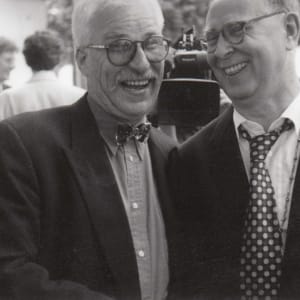"Cotton Palm", unframed black and white print, Berlin 1960s
Sale price:2 002,36 USD
Additional details
Units (cm/inches):cm
Height:29.7
Width:20.9
Medium:Lithograph,Offset
Materials:Paper
Description
Sigmar Polke (1941-2010) was one of the most important german artists of the late 20th century. In 1961 he joined with Manfred Kuttner, Konrad Lueg and Gerhard Richter the class of Karl Otto Götz at the Kunstakademie Düsseldorf and these four upcoming artists presented their latest works in an in their own initiative curated exhibition to bring the newest art movements from oversea and Paris to Germany. On the invitation cards they printed the terminologies „Pop Art, Junk Culture, Nouveau Realisme, Common Object Painting, Neo Dada, New Vulgarismus, Antikunst, Know-Nothing-Genre“ and they proclaimed for theirselves to be the first artists to show a indepently grown Pop Art in Germany, not just as a copy or American import. But Polke showed right from the beginning an ironic distance to the sociocritical style of his combatants, that will run through his entire Ouevre. Influenced by the Fluxus and Neo Dada scene around Joseph Beuys, Daniel Spoerri, Dick Higgins and others in the early 1960s Polke developed is own style characterised by an anarchic mind and esprit. Simliar to the Pop Art Polke searched for the asthetic in the trivial but here too he simoultanesly disavowed the trivial through irony. Very typical for Polke are the famous grid images, known from newspaper printings, where there are horizontal, uniform lines of small dots and by combining certain dots there arises a form. By using perforated sheets and airbrush he could overlay more monochrome grids to create vibrating images and he often played in the printing process with enforced mistakes and errors to disassemble the firm surface of an image to a process of dekomposition. Next to irony and anarchy other keywords to his works are heterogeneity, polyperspectivity and multivalent metamorphoses in which every reality could be something possibly different at the same time. A world where everything is connected; not by fundamental unity but by fragmentary dispersion. Because there is no one true reality, he transfers his works in an intermediate state of transformability. Wattepalme (Cotton Palm, 1966) From the portfolio ".....Höhere Wesen befehlen" (.....Higher beings ordain) Offset lithograph after photographs by Polke and Chris Kohlhöfer on beige art paper 22.2 x 16 cm (print size) 29.7 x 20.9 cm (sheet size) Edition of 80 and a few prints outside the complete folder. Nr. 6/6 unsigned extra prints, stamped and signed by the editor (Edit. Block) Cat. Raisonné (Edit. Becker/von der Osten) Nr. 8 The portfolio ".....Höhere Wesen befehlen" was published in 1968 by the Gallery René Block in Berlin. In addition to the edition of 80, they printed also a few extra prints from each motif and in contrast to the largely unnumbered and unsigned editions the extra prints were numbered and stamped and signed by René Block. The photos in the portfolio are not intended to be simple images of objects in action, but to function as direct carriers of the idea of what is shown. The objects shown do not exist either, but were created for the sole purpose of showing them as photographs. The "Wattepalme" belongs to a series from 1966 called "Die betende Palme" (The praying Palm) that shows various materials in different states in the form of palm trees made with little effort.


